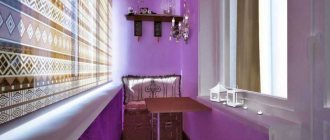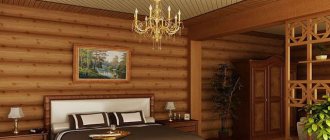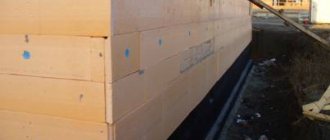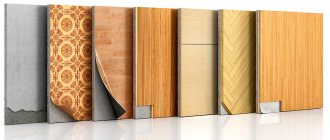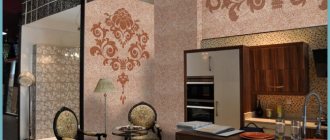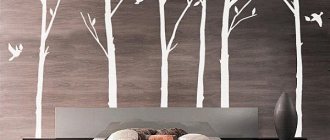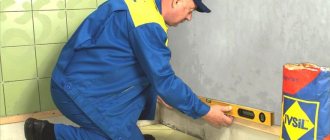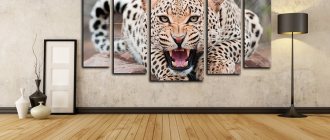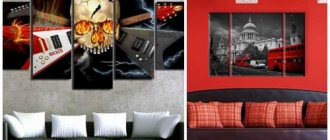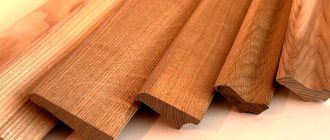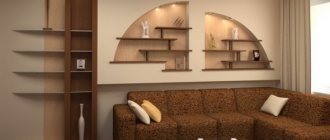Types of insulation
Today there is a large selection of what can be used for thermal insulation:
- mineral basalt wool;
- glass wool;
- expanded polystyrene (foam);
- extruded polystyrene foam (EPS);
- foamed polyethylene.
Fibrous materials
Mineral wool and glass wool belong to the class of fibrous insulation. They are mats or rolls of compressed fibers. There is air inside between the fibers.
A characteristic feature of such materials is a sharp decrease in thermal insulation characteristics when wet, which entails the need to use additional vapor barrier on the room side.
The insulation is placed between the outer and inner layers made of brick or concrete.
Foam materials
Polystyrene foam and EPS, similar in properties, in the form of plates have a closed cellular structure. Air enclosed inside cells isolated from each other is a good heat insulator.
A significant advantage of such materials is that they are not afraid of moisture. No additional protection is required when using them.
Relatively recently, a new roll material has appeared - foamed polyethylene with a thickness of 2 to 10 mm, foiled on one or both sides with aluminum. It can be used as an auxiliary material to improve the thermal insulation properties of the entire wall structure.
Foil polyethylene, in addition to its direct insulation function, is capable of creating a vapor barrier and a screen that reflects infrared heat from heating devices into the room.
Manufacturers and prices
Which manufacturers can offer us the best selection of high-quality insulation materials and at what price?
Penoplex
Without a doubt, the most popular material for wall insulation today. Very convenient to use. Standard sizes are 50 cm or 1000 cm in length and 50 or 100 mm in width.
The material forms joints that must be sealed using polyurethane foam. In general, the material has excellent thermal insulation properties. But it needs to be laid in several layers.
The photo shows penoplex for home insulation
In addition to walls, penoplex can also be used to insulate both the ceiling and the floor. In this regard, the material is universal. But how to glue penoplex to concrete and how to do it correctly is described in this article.
Penoplex is inexpensive - a standard sheet of material costs 175 rubles. If the product level is higher - the so-called Penoplex comfort - 290 rubles. A package of 8 half-meter sheets will cost the buyer 1,200 rubles.
Ursa
This is also a well-known manufacturer of finishing materials. The brand's mineral wool is of high quality and has excellent thermal insulation properties. The material is universal, suitable for insulating walls, roofs and floors.
In the photo - ursa for insulating the inside of a house
Izover
This manufacturer offers us fiberglass insulation that meets the latest technological characteristics. Isover insulation is not afraid of shrinkage and is made from non-toxic, safe materials. Easy to install, easy to transport, not afraid of moisture.
Isover in the photo
A package of 7 slabs 100 mm thick and 1170 cm long will cost 490 rubles. A package of 14 50 mm thick slabs of the same length has the same price.
Rockwool
This brand offers us to use insulation in the form of stone wool. Its advantage is that the material is light in weight and convenient for installation and transportation. The material lasts a long time, is durable, is not afraid of dampness and retains heat well inside the house.
In the photo - rockwool for insulating the interior
The price for a package of 5 slabs 100 mm thick and 1000 cm long is 610 rubles. A package of 10 50 mm thick slabs of the same length has the same price.
Knauf
The well-known German brand produces very high-quality insulating materials. In addition, it is very economical - during installation there are practically no unnecessary pieces or scraps left from it - all the material goes into use.
In the photo - Knauf for insulating the interior
The most famous and suitable insulation of this brand for our dachas is Knauf Cottage Plus. Its cost is 740 rubles per package of slabs 610 mm wide, 1230 cm long, 8 sheets per package.
Insulation of internal surfaces of a corner apartment
Every apartment building has corner apartments. Their disadvantage is that they are blown by the wind from all sides, so the issue of insulation is very acute. The recommended insulation material is penoplex. By using a small layer thickness, high-quality thermal insulation can be achieved.
The insulation features are:
- the base must be carefully prepared for work: cleaned, coated with an antiseptic, impregnated with a primer;
- penoplex can be attached directly with glue or bars that are pressed onto the insulation;
- The seams between the sheets are sealed with polyurethane foam;
- Reinforcement of the base and application of finishing.
It is important not only to insulate a corner apartment from the inside, but also to finish the walls on the outside. When using penoplex there is no need to use a vapor barrier
When choosing other insulators, it is there. Since it is quite possible to insulate corner apartments with your own hands, it is important to strictly follow the technology for attaching the insulator. This procedure will protect the room from heat loss and reduce heating costs.
Technical standards
Starting in March 2021, changes in legislation came into effect. Country real estate was divided into two categories:
- Garden building. This term refers to any structure for living in the summer. In fact, an outbuilding, a rustic log house or a huge cottage can have this status. In this case, the requirements for indoor conditions are not regulated in any way.
- Individual housing construction project (IHC). If a building is given this status, you can register in it as if you were in a city apartment. It must be suitable for year-round use. GOSTs and SNiPs for residential buildings apply here. To transfer the building into an individual housing construction project, you will need to undergo project approval. The commission will also consider the properties of enclosing structures. For the coordination to be successful, heat loss must not exceed a critical level.
The basic requirements are set out in SNiP 3.03.01 and the manual PZ-2000. Materials produced by modern manufacturers comply with these standards, however, in some cases it makes sense to carry out thermal engineering calculations. It is necessary in regions with damp and cold climates, where higher requirements are placed on the coating than usual. Design organizations will help you correctly calculate the required parameters.
Energy saving when insulating walls outside
- Brick and concrete tend to accumulate temperature and return it gradually. When the walls of a house are insulated from the outside, the cold does not reach them, but they warm up from the inside. After 10 minutes of airing the rooms, the temperature in them hardly drops a couple of degrees.
- Porous thermal insulation material only impedes air movement. But it is not able to accumulate heat. When the insulation is located in a house whose walls are frozen through, an open window cools the room in 5 minutes. It will take a long time to restore a stable temperature regime.
- In addition, the internal placement of insulation does not cover the cold bridges formed by the floor slabs. Enormous heat losses are inevitable. External insulation of walls removes them from the zone of influence of external factors, which significantly extends their service life.
In what cases is it permissible to insulate walls from the inside?
Only in a few cases, when there is no other choice, can you take a risk and insulate the walls from the inside:
- authorities ban on changing the façade of a building (cultural value of the building, the front side of the building facing the central streets, etc.)
- behind the wall there is an expansion joint between the buildings;
- behind the wall there is an elevator shaft or other unheated room in which it is not possible to install insulation.
In addition, insulation from the inside can be effective and acceptable only if this is included in the construction project, such as in modern construction of frame houses. In this case, if the insulation is insufficient, you can strengthen the existing one with the necessary layer of the same insulator that was used during construction. The same can be said for wooden walls. If you need to insulate them from the inside, then all wood is used.
Other reasons to insulate the walls of a house from the inside cannot be reasoned. It is best to insulate from the outside, even if this means changing or transferring the exterior design to a new exterior covering.
If, for objective reasons, it is decided to carry out insulation indoors, then you should take this process as responsibly and carefully as possible, starting from the choice of materials for insulation, and ending with installation.
Rolled thermal insulation
Penofol
Penofol is a combination of polyethylene foam and aluminum foil. This is a whole series of materials (including single-sided, double-sided, laminated, with an adhesive layer). Moreover, it can be used both in combination with other heat-insulating materials, and independently. By the way, penofol is popular for insulating a bathhouse from the inside, and there is much more steam there than in an ordinary living room.
To insulate a cold wall, use penofol with one layer of foil (one-sided) and up to 5 mm thick.
In the case, as with liquid ceramics, the effect is achieved due to the low thermal conductivity of foamed polyethylene, as well as its low vapor permeability and high reflective properties of foil (up to 97%).
But unlike seamless coatings, complete sealing and prevention of cold bridges cannot be achieved. Consequently, condensation may form on the surface of the foil. Even the obligatory sealing of the joints with adhesive aluminum foil will still leave gaps inside between adjacent sheets.
The traditional method of combating the formation of condensation on foil is lathing with a ventilated gap between the penofol and the outer cladding.
Polyph
Another version of foamed polyethylene, but already made in the form of a kind of wallpaper - there is a layer of paper on both sides. Polyfoam and is intended for gluing wallpaper onto it.
Of course, its thermal insulation properties are not as high as those of penofol, but they are quite sufficient to make a cold wall feel warmer to the touch.
In most cases, the insignificant thickness of the insulation does not lead to the dew point moving to the inner surface.
The disadvantage of this method is that only a dry wall is insulated.
Materials
Lightweight cladding can be covered with plaster on top.
According to its technical characteristics, work on installing a heat-saving coating in a panel house from the inside is carried out from the following common materials:
- mineral wool;
- Styrofoam;
- extruded polystyrene foam;
- polyurethane foam;
- foil (reflective) thermal insulation;
- insulating paint.
When installing light insulating cladding, walls without lining the top with durable sheets of insulation boards (foam plastic, expanded polystyrene, stone basalt wool) are simply hidden with a layer of plaster:
Foam tolerates moisture well
An important criterion for selection is the non-flammability of the material and environmental safety, since it is installed indoors.
You can compare the indicators that this or that thermal insulation has using the table:
You should pay attention to fluctuations in humidity in the room - on the one hand, in excess quantities it can negatively affect the characteristics of insulation (mineral wool), on the other hand, condensation retention contributes to the appearance and development of fungus and other microorganisms (foam plastic).
Roll materials
Mineral wool is a fireproof material
Mineral wool is a popular option for insulation because it has a number of undeniable advantages:
- Easily cut into pieces of the desired size.
- Repeats the shape of the surface (tightness).
- It is sufficiently vapor-permeable so that additional membranes are not used in the design.
- Does not burn, unlike polymers, does not produce toxic smoke when heated.
- Resistant to microorganisms.
Available in the form of rolls, stitched mats and slabs. Of all types of this material, stone basalt wool is preferable.
Foil materials reflect heat waves inside the room
Foiled polyethylene foam is used to reflect infrared radiation and create a barrier to water vapor. Heat rays practically do not penetrate to surfaces hidden under the finishing sheet covering, so there is little point in installing reflective insulation in the walls.
Can be used as protection of mineral wool from a wet wall, additional sound insulation, vibration damping.
Natural cork is used for high-quality internal insulation of small thickness on panel walls. This is the most environmentally friendly heat insulator. Performance characteristics include high strength, low thermal conductivity, low weight, durability, and elasticity. For more information about which insulation is better, watch this video:
Production is carried out both in rolls and in the form of individual slabs, which look good on the wall without subsequent finishing. The cork is resistant to biological influences.
Foam boards
Seal the joints of the plates with sealant.
The technology for insulating the walls of a panel house from the inside with even, rigid slabs of foamed polymer includes careful preparation of the surface for installation. Unresolved wall deflections will create voids in which condensation will accumulate.
The slabs are laid out staggered on a layer of glue; the use of anchor umbrellas in this case is not recommended (through passages for cold). Each joint is sealed with sealant. Another method of fastening is to lay it between a T-shaped profile fixed to the ceiling and to the floor.
The thickness of the material will depend on the climate zone. The following initial data can be used in the calculation:
Extruded polystyrene foam has a higher density and a lower degree of flammability.
Liquid formulations
Applying a layer of polyurethane foam requires special equipment and installation of a frame. The work is carried out by specialists with practical experience. The strength of the hardened foam is low and it is covered with a protective cladding (gypsum plasterboard, plywood). For more information about polyurethane foam insulation, watch this video:
Liquid types of insulation include the achievement of modern science - special paints. They are expensive and require careful adherence to application technology (thickness and sequence of layers, direction of brush movement). If the instructions are violated, the thermal resistance of such a coating decreases sharply.
Features of indoor wall insulation
Indoor walls can be insulated only in cases where the facade of the building cannot be changed or there is no access to the outer surface of the wall. It is recommended to avoid insulating walls from inside the house because it has a number of significant disadvantages:
- The dew point moves indoors. The wall begins to freeze through its entire thickness, the cold meets warm air at the junction of the wall and the insulation, and condensation forms on its surface. This has many negative consequences: fungus can develop on a wet wall, the effectiveness of the thermal insulation material decreases, it lags behind the wall and collapses; In addition, the decorative finish deteriorates.
- A frozen wall loses its heat-accumulating properties. It becomes difficult to control the temperature of the air in the room - it begins to warm up faster due to the operation of heating devices or direct sunlight entering the window and cools down faster when ventilated.
- It is impossible to provide 100% thermal insulation, since it will not be possible to insulate the walls from the inside over their entire surface - cold bridges will remain at the intersection of the external wall with the internal partitions.
- The humidity in the room increases. This, again, contributes to the formation of mold and is generally harmful to health. To ensure good air exchange, you will have to constantly ventilate the apartment, which will lead to increased heating costs.
- The useful area of the apartment decreases - especially if, due to climatic conditions in the region, it is necessary to install a thick layer of insulation for the walls of the house.
- If thermal insulation work is not carried out before starting renovations in the room, all decorative finishing has to be dismantled, which complicates the work and makes it more expensive.
The most dangerous consequence of internal thermal insulation is condensation inside the room, which leads to accelerated destruction of walls and damage to finishing materials. This can be partially avoided by accurately calculating the required thickness of the insulation layer and choosing the right material. Thus, insulating a house from the inside is expensive and unsafe, but sometimes unavoidable.
Advantages of internal insulation
The main advantage is the ability to do all the work yourself. The equipment and tools needed are standard, and there is no need to have special skills. Those who want to get the following benefits can insulate a wall in an apartment:
- relatively low price;
- lack of dependence on weather;
- insulation allows you to level the surface of walls that need it.
The advantages are significant, but there are also significant disadvantages. On average, the work takes one day. You can handle the wall treatment yourself in a day, or you can stretch out the installation for a longer time - a lot depends on the person’s intelligence, skills and experience. At the same time, it is not necessary to be a professional - if a man has previously worked with fasteners and other materials, he will succeed.
Brief overview of materials
When considering the materials that are used for internal insulation of housing, it is worth paying attention to several of the most popular options used for both residential (private and multi-apartment) and public buildings:
- Foamed polyethylene (penophenol), installed so that there are two gaps in the structure - between the interior decoration, insulation sheets and the wall. However, violation of the technology leads to a shift in the dew point and moisture entering the material. To improve performance parameters, penophenol is used together with other insulation materials.
- Expanded polystyrene (foam plastic) is practically the best thermal insulation of walls from the inside, with minimal weight and low thermal conductivity. The moisture resistance of the material allows you to do without vapor barrier. Among the disadvantages is the release of harmful substances during combustion.
- Polyurethane foam, which also has good thermal insulation properties and easy installation. Provides maximum sealing, but the disadvantages include, as for foam plastic, the release of harmful substances during combustion.
- Spraying is an option that leaves no seams. Suitable not only for internal, but also for external insulation. Considered suitable only as a finishing touch.
- Paint based on ceramic components. It dries quickly (after 12 hours wallpaper is glued over the material), but does not protect against dampness - and therefore against mold and mildew. Used as an additional layer.
Cork is considered an expensive (and this is practically its only drawback), but effective material for insulation. Provides good protection of rooms from heat loss, does not require wallpapering or painting, and does not reduce the area of rooms. Due to its low heat resistance, mineral wool is considered not the most suitable option for internal insulation. Therefore, it is rarely used and only in extreme cases. Due to the low resistance of the material to moisture, rooms insulated from the inside are at risk of dampness and, as a result, the appearance of mold and mildew.
Basic principles of internal thermal insulation
The correct choice of thermal conductivity of insulation makes work on internal insulation as effective as creating an external thermal layer, provided that the heat barrier is correctly placed.
Not every heat-insulating material is suitable for insulating a house from the inside. It must meet certain properties to achieve the assigned tasks:
- Low permeability.
- No secretions harmful to human health.
- Waterproof.
- Ability to maintain configuration under mechanical loads.
It is important to know! The vapor permeability of insulating materials should decrease, that is, the insulation must provide more reliable protection for vapor than a wall. This purpose guarantees the free exit of moist air through the thickness of the wall to the outside.
To avoid problems with insulation from the inside, first of all, you need to determine the location of the dew point. Its correct position should be in the wall or insulation, but not at the junction between them.
Changing the location of the dew point Source mynovostroika.ru
If this happens, then the accumulation of moisture and, as a result, rot, mold and mildew on the surface is inevitable. This situation is possible due to the large thickness of the insulation, since the wall is completely insulated from internal heat.
This also happens as a result of low vapor permeability. Walls made of brick and concrete are especially susceptible to this phenomenon. In this regard, internal thermal insulation in such houses is justified only in non-alternative options.
But in buildings made of timber or logs, such a layer of insulation is quite acceptable; you just need to maintain a gap between the wall and the insulation. Therefore, in order to meet all the requirements for internal insulation, you must first make a frame on the wall from a vertically located beam along the width of the insulation size.
Then a waterproofing film is spread and secured along the wall and insulation material is placed between the slats. It, in turn, is fixed with transverse strips and then a vapor barrier film is stretched on top.
When walls are insulated internally, such a “pie” is created Source moydom-irk.ru
Why insulate a corner apartment?
The layout of corner apartments in terms of energy consumption for heating is not the most optimal due to the presence of two external walls. And as a rule, in such conditions, even the presence of additional heating devices does not save residents from the cold. Before the heating season, when the temperature outside drops sharply, heat begins to quickly leave the room, which is why the apartment becomes cold, dampness and fungus appear. If the walls are not insulated, it will be uncomfortable to be in such a room.
Freezing corner in the apartment
When the central heating comes on, the situation improves slightly as it becomes warmer, but corner walls can freeze. This leads to damage to the plaster layer and peeling of the wallpaper. As a result, mold and various types of fungus begin to develop in such places. Such a microclimate causes discomfort and does not have the best effect on the health of residents. Due to the dampness and low temperatures, colds are becoming a common occurrence for many residents of corner apartments.
Features of insulating a bathroom in an apartment
Many users are interested in how and how to insulate a bathroom in an apartment. A special feature of the room is the frequent influence of temperature changes and high humidity. In this room it is necessary not only to insulate the base, but also to properly organize the removal of excess moisture. If cold walls are constantly in contact with it, the decorative finish will deteriorate.
To insulate this room, those materials are used that show stable technical characteristics in damp conditions for a long time: polystyrene foam, penoplex, cork-based insulation. Since the first type of material is the cheapest, it is used most often. The insulation technology is as follows:
- Dismantling old finishing.
- Surface treatment with an antiseptic composition and deep penetration primer.
- Laying insulation. Fastening is carried out directly to the wall with “fungi”, using glue (a composition that performs well in conditions of high humidity and temperature is selected) or between profiles (if moisture-resistant plasterboard is used for cladding).
- Filling the resulting voids. For this, polyurethane foam is used. Its excess is cut off after hardening.
- Foam reinforcement. To fix it, glue is used, with which the sheets are attached. The mesh should be completely covered with the composition.
- Finishing wall putty or installing drywall.
The ceiling in the apartment, namely in the bathroom, is also insulated. The technology of work is the same as in the case of walls.
Features of insulation of wooden houses (log houses)
Most rules for installing thermal insulation apply to brick, concrete or cinder block walls. However, there are many wooden houses built in the traditional way. In them, the insulation procedure is carried out differently, since not the entire plane is subject to treatment, but only the inter-crown connections.
For them, special materials are used in the form of strips, strands, and foaming compounds. If all strips of joints are tightly filled with insulator, a log (or lumber) house can retain up to 95% of thermal energy. All you need is high-quality ventilation (or an ordinary Russian stove with good draft).
How would you insulate your home?
InternalExternal
Insulating a house is a procedure that requires an understanding of many physical processes occurring in structures. The success of insulation installation depends on the correct choice of materials, compliance with installation rules, and the experience and skills of workers.
If mistakes are made at the installation stage, you can get undesirable consequences in the form of point pockets of moisture penetration and destruction of load-bearing structures. Therefore, before starting work, you need to carefully examine the house, analyze the working conditions of the walls and ceilings and select the most effective insulating materials.
Wall insulation process
Regardless of the type of insulation, the installation process has mandatory stages. The service life of the material and the temperature regime in the apartment itself depend on the quality of their implementation.
Preparation
One of the important points is preparing the walls for installation of insulation. First of all, the old coating is removed from all surfaces. Wallpaper can be easily removed if you first spray it with water and then use a spatula to remove the paper from the walls. If even the slightest particles remain, this may prevent the insulation from fully performing its functions.
If the wall has unevenness, it will need to be leveled. This requirement can be achieved using putty or drywall. But in the latter case, the material can already become a kind of additional insulation. This approach is used for significant wall defects (irregularities more than 1 cm) and it requires additional financial investments, since drywall is attached only to a metal frame.
After the wall has been cleaned and the putty has completely dried, it is treated with a special antiseptic solution. This layer provides protection against mold and mildew in the future. There are different mixtures, each of which has its own method of application. Manufacturers indicate instructions for use on the packaging of the mixture, so there will be no problems with mixing. Next, the surface is coated with a primer in two layers - each subsequent one is applied after the previous one has dried.
Before insulating a wall in a corner apartment, you need to process the connection points with the ceiling and the corners from the inside. In such areas, a heat and vapor barrier is applied. Then they can be disguised using a box or false column.
Installation
For high-quality insulation you will need to make a “pie”. In this case, it will be several layers of different materials, each of which has its own purpose. Depending on what material was chosen for insulation, installation can be carried out using glue or creating a frame.
The method of attaching the insulation directly depends on the finishing of the walls. Therefore, insulation in the room can occur in one of the following ways:
Frame. Used when there is no need to plaster the walls. This approach allows you to protect fragile insulation (for example, polystyrene foam) from mechanical damage. To create a base, wooden blocks (pre-treated with an antiseptic) or a metal profile may be suitable. Dowels or self-tapping screws are used for fixing to the surface. The distance between the posts should be equal to the width of the material. If the insulation has a dense structure, then the cell should be exactly 50 cm smaller than the dimensions of the slab or roll. In the case of soft material, the cell size will need to be reduced by 1.5-2 cm. As soon as the insulation is laid in the gaps, all joints are treated with polyurethane foam. After it dries, you will need to remove all its excess using an ordinary or stationery knife. Next comes the finishing touches.
Laying mineral wool
Glue. This type of fastening requires careful preparation of the walls, which includes leveling. All cracks are treated with putty, and if there are protrusions, they must be chipped off, and such places are sealed with mortar. To apply the glue you will need a notched trowel. The solution is prepared according to the manufacturer's instructions, which are indicated on the packaging. The mixture is applied to the wall and to the insulation, after which the material is pressed tightly against the wall. The glue dries for 2-3 days, depending on the manufacturer, after which you will need to additionally secure the insulation using umbrella dowels.
Fixing the insulation with glue
Fixation with glue is acceptable in cases where insulation is carried out using polystyrene foam, wood fiber, penoplex or foil insulation. For other materials, a frame system can be used.
Features of insulation from the inside
The main problem with internal wall insulation is the fact that the wall itself does not become warmer and even begins to freeze more. This causes the dew point, that is, the place where moisture from the warm air in the room begins to condense, to be transferred even closer to the inner edge of the wall or to its surface. In this case, condensation will inevitably lead to dampness and destruction of the wall itself and the finishing layer, deterioration of the thermal insulation properties of the insulation material and, as a result, heat loss will again be high and plus even greater humidity. Brick walls will suffer the most damage from dampness.
The work of insulation inside and outside in practice: a visual diagram
To avoid this, it is necessary to choose insulation with minimal vapor permeability, moisture absorption and the absence of any seams or joints during installation through which condensation could escape into the room, and air into the space between the wall and the insulator. Materials such as mineral wool, liquid ceramics, cork, plasterboard, warm plaster, etc. do not meet these criteria at all. The last two options can only be used as the final stage of insulation.
The use of expanded polystyrene (penoplex) is also very questionable, since it is difficult to achieve a reliable connection with the wall without the use of solutions, and the joints between the sheets will play an important role in deteriorating the tightness.
When is internal insulation important?
The best solution for preserving heat is to insulate the wall in the apartment. However, this often costs a large amount of money, since the work requires not only special materials, but also equipment from specialists who know all the intricacies of the matter.
When internal wall insulation is relevant:
- the façade of the building should not be subject to changes;
- the presence of expansion joints in buildings;
- location of external premises behind the wall of the apartment (for example, an elevator shaft);
- high cost of work.
Mineral insulation
These include mineral wool, expanded clay, and cement-based mixtures.
Mineral wool is considered one of the most popular materials for floor insulation. Most often it is used to insulate floors on the first floors or attics. The material is durable and will be worth the money spent on it. Cotton wool contains rocks, slag or glass. Depending on the raw material, it is divided into glass wool, basalt (stone) and slag.
Mineral wool is available in the form:
- Slabs
- Rolls
- Matov
These forms of material greatly simplify the work of insulating floors. The insulation is placed on a concrete base and covered with a layer of vapor barrier material. A wooden or artificial floor is installed on top.
Among the advantages of mineral wool is its non-flammability. It prevents the spread of fire, thereby increasing the fire safety of the entire room. Mineral wool has high thermal insulation properties and excellent sound insulation. It does not freeze or deform due to temperature changes, is not susceptible to mold and mildew, and is vapor-tight.
The disadvantages of a heat insulator are considered to be the impressive layer height and the need for additional waterproofing, since not all types of wool are moisture resistant. Glass wool is most resistant to moisture, but it is not very convenient for installation due to the flowability of small glass fragments. The presence of formaldehyde in cotton wool raises doubts among those who strive to create an environmentally friendly space in their home. However, you can avoid contact with unwanted chemical elements by working with the material correctly.
Expanded clay is a granular insulation material based on clay. In terms of cost, it is considered one of the most affordable. Expanded clay bedding for thermal insulation increases the height of the subfloor by at least 12-15 cm, so it is carried out during construction work or major repairs.
Expanded clay has good thermal insulation and strength. It is environmentally friendly, resistant to low and high temperatures. The material is considered an excellent sound insulator. Among the disadvantages of insulation are its fragility and high moisture permeability, which in some cases is absolutely undesirable.
Expanded clay can be used with cement mortar. In this case, the floor is filled with a mixture consisting of 1 bag of cement, 2 bags of sand and 3 bags of expanded clay. This expanded clay cement screed is quite durable and provides good thermal insulation of the floor in the apartment.
Cotton insulation
Probably the most environmentally friendly insulation for the home is cotton mats. The material can be rolled. Cotton insulation is made from recycled cotton fabric, simply from jeans and polyester fibers. The percentage of components is 85% cotton and 15% thermal bonding fibers.
Available in the form of mats measuring 1000 by 600 millimeters, with a thickness of 20 or 50 mm and a density of 45 kg/m3 or 80 kg/m3, respectively. The thermal insulation qualities of cotton insulation are not inferior to basalt wool, and at the same time it has excellent sound insulation.
Due to its properties, cotton as an insulation material is used for paneling and interior decoration of such specific premises as a home theater. Insulation work can be carried out independently. The environmental friendliness of the product allows you to do without the use of personal protective equipment.
The disadvantage of using this heat-saving composition is the difficulty of cutting it.
Technology of internal thermal insulation works
Thermal insulation of internal walls consists of a certain number of steps. Their number and order are affected by the selected type of insulation. Thermal insulation material is attached to the wall using glue or mounted on a special frame.
Let's look at a brief instruction on how to insulate walls from the inside:
- We prepare the walls.
- We assemble the frame using a metal profile.
- We install insulation.
- We install a vapor barrier.
We decorate the wall with gypsum board sheets and plaster it. Next, painting, wallpapering or cladding with decorative panels is your choice. There are no restrictions in the choice of finishing options.
Insulation on the frame
Like a wall from the inside of a room on a frame? This thermal insulation of walls from the inside is a labor-intensive process, but more reliable. Thanks to the frame, the fragile material is not subjected to mechanical stress, this is especially true if foam plastic is chosen as the thermal insulation material.
There is no need to level the wall, but before installation it is worth clearing the surface of the plaster, if it has peeled off, dirt, dust and covering it with an antiseptic compound.
The frame is constructed using aluminum profiles or bars. Fastening is done using dowels or self-tapping screws, depending on the material from which the base is made. The pitch of the racks should be equal to the width of the material, for example, if soft insulation is chosen for walls inside the walls, then the distance is reduced by two centimeters; when using polystyrene foam or polystyrene, it is exactly 60 cm.
If you decide to use wooden elements as racks, then they should be treated with impregnation, which will prevent rotting and the formation of fungus.
As soon as the frame is ready, heat insulation is placed in the gaps, and all seams between the material are sealed with polyurethane foam. After the foam has dried, it is cut flush. After this, you can begin the final finishing.
Thermal insulation of indoor walls on the frame is made with the following materials:
- glass wool;
- basalt insulation;
- Styrofoam;
- wood fiber.
Any of the above materials can be mounted using lathing on the walls, except for foil insulation.
Installation of insulation with glue
This type of installation requires careful preparation of the wall plane before insulation.
They are cleaned of dust and contaminants and degreased. Further work proceeds according to the following algorithm:
- After cleaning, the walls must be leveled and repaired. The cracks are filled with putty, large protrusions are knocked down, and the depressions are sealed with mortar;
- all surfaces are treated with an antiseptic or primer with an antimicrobial effect;
- the primer is applied in two layers;
- after drying, you can begin installing the slabs with glue; it is applied to the wall and to the material using a notched trowel;
- the glue will dry for 2-3 days;
- as soon as the surface dries, you need to perform additional fixation with umbrella dowels.
Do not forget that the installation of layers of material is carried out offset. In this case, it is necessary to waterproof the base surface and vapor barrier the insulation itself after installation.
The installation of insulation with glue has its limitations, since only dense pits are used for this, for example:
- Styrofoam;
- wood fiber;
- penoplex;
- forged insulation.
As soon as all the installation of the heat insulator is completed, finishing begins.
Technology
To insulate panel walls inside a house or apartment yourself, you need to follow the instructions. The step-by-step algorithm of actions is as follows :
- Calculate the required amount of material and purchase it.
- Prepare the surface for upcoming work. To do this, the walls are thoroughly dried.
- Remove old coverings in the form of wallpaper, paint and other decor. If plaster has been applied to the wall, it is removed down to the concrete panel.
- Clean the wall from dust and other contaminants.
- Prime the surface using a deep penetration solution. It is recommended to apply at least 2 coats of primer.
- Leave the walls until completely dry.
- Formwork is installed into which layers of insulation, for example, mineral wool, are installed.
- If formwork is not needed, insulation is attached. There is a specialized adhesive for each material.
- Seal the joints with sealant.
- Cover the structure with slabs or other finishing material.
If all technologies are followed, a comfortable temperature will be maintained inside the room. Wall insulation is good not only because it prevents its deterioration in winter, but also helps to maintain coolness in summer.
Important ! You can start insulating walls only in summer or early autumn. During the cold season, this work is not done.
Insulation methods
Most often, an apartment loses heat through the walls. If a room freezes in winter, the temperature drops and the humidity rises. The floor becomes cold and mold may develop over time.
What is the best way to insulate the walls of an apartment? To give the correct answer, you need to determine how to do it: from the outside or from the inside. Each insulation method has its own advantages and disadvantages.
Internal insulation
At first glance, it may seem that insulating walls indoors is easier. There is no need to call climbers; there will always be access to the insulation structure to replace some materials. However, practice has shown that insulation from the inside is ineffective and has many disadvantages:
- the living area of the rooms is reduced, especially in cases where several walls are insulated;
- internal insulation will require you to change the interior, you will have to move furniture, carry things;
- Residents are usually evicted during insulation;
- the most important thing is that we isolate the wall from the heating system.
A layer of insulation will appear between the wall and the space of the apartment. The insulation will prevent heating.
If the wall is constantly cooled, this can cause it to fail prematurely. Condensation will form between the wall and the insulation, and moisture will begin to penetrate into the rooms. The advantages of internal insulation include perhaps the lower cost of work.
External insulation
Thermal insulating material is attached to the facade of the building, covering all external walls of the apartment. Insulating apartment walls externally has several advantages:
- the area of the home will not decrease;
- all work will take place outside the window, you won’t have to move furniture or move to relatives for a few days;
- the walls will not freeze or thaw, which will eliminate the appearance of cracks;
- The humidity in the apartment will decrease.
Is it worth insulating walls from the inside?
There are two opposing opinions: walls should not be insulated from the inside, since the cold penetrates from the outside, which leads to the formation of condensation due to the dew point. And moisture, as we know, is a substrate for the formation of mold and rot. Therefore, the barrier from the cold needs to be “erected” in the same place - from the side of the facade. And the second opinion is that insulation from the inside is an excellent way to increase the thermal characteristics of a room. There are many pros and cons for both options.
Indeed, since cooling occurs outside the building, proper insulation of the facade will be more effective. But what to do if a beautiful modern façade with insulation has already been completed, but it’s still cold inside? Or the apartment is located in the historical center, and the cold wall outside is a historical monument. Or, what’s even more unpleasant, it’s located at the height of the 10th floor. The separately insulated part of the wall on the facade looks ugly, like a patch. Or it is not possible to obtain permission from the HOA (Home Owners Association) for this construction operation. But insulation from the inside can spoil the mood of the owners. That is, sometimes you have to make a decision from the current situation, and often there is only one way out - to insulate yourself from the inside.
Roof insulation
Insulating the roof of a house
Often, together with the ceiling, the roof of a frame building is insulated with mineral wool. For example, if the attic floor is residential and heated. If the attic is not heated, the floors between floors should be insulated. A prerequisite for insulation is stretching the waterproofing material over the insulation to protect it from environmental influences. How to make the roof insulation process easier?
It is more convenient to carry out work outside. If you decide to insulate with mineral wool from the inside, be prepared to handle an uncomfortable material that crumbles onto your face and head. After installing the skeleton of the pitched roof, a layer of vapor barrier is hemmed from below, which is stuffed from the inside with boards, plywood or sheathing material. This way you can easily lay sheets of insulation on the outside according to the scheme for insulating other parts of the house.
The sheathing and roofing material are pressed onto a waterproofing membrane laid on top of the insulation. Of course, if the roof is already ready, there is nothing left to do but insulate it from the inside using temporary fasteners.
On a note! When using roofing sip panels, there is no need for additional insulation. The panel resembles a sandwich of two OSB sheets with a layer of 200 mm foam. The panels are laid on a wooden base and connected into grooves with beams.
In houses made of timber, roof insulation is also carried out. Usually, basalt wool is used for this, slabs of which fill the space between the rafters. A vapor barrier is installed on the attic side, and a membrane film is protected on the roof side.
Non-standard method of insulation - electric
A new, but quite effective way to insulate walls in a corner apartment is to use the principle of heated floors. Panels with electric heaters are mounted indoors on the surface of the walls and connected to the electrical network. The control unit is installed in a separate accessible place
For proper installation, it is very important to wait for frost, and then turn on the equipment until the walls are completely dry. Only after this an additional thermal insulation layer is laid and decorative finishing is performed.
This method of insulation is very effective, but has one big drawback. In cold weather, you will need to regularly maintain a stable temperature to prevent the formation of dampness and condensation. This will lead to additional energy costs. The purchase of an insulation system itself will require considerable expenses, and after that you will have to pay for regular operation. However, this approach allows you to create an ideal microclimate inside the corner room in cold weather.
Alternative modern insulation materials
There are many non-standard alternative ways to insulate corner apartments. They are distinguished by the use of modern innovative materials.
Polyurethane foam
PPU insulation meets all requirements for vapor barrier, water absorption and absence of seams. Therefore, even if there is a dew point inside the layer, it will remain “conditional”, since there is no condensation in vapor-tight materials. This results in a completely sealed thermal insulation layer from the room side.
Wall insulated with polyurethane foam
Keramoizol
Keramoizol
A modern building material characterized by increased thermal insulation. Sold in liquid form. For maximum effective insulation, 6 layers are laid on the wall in a direction perpendicular to each other.
Astratek
Astratek
Astratek is a liquid insulation material. It can be applied to the surface with a spray or brush, and after drying it forms a durable and elastic substance with a porous structure. Such insulation perfectly allows air to pass through, but effectively retains heat inside the building.
Liquid thermal insulation using Mascoat paint as an example
Mascoat
The paint from a well-known American manufacturer has increased thermal insulation properties and also repels moisture very effectively. Its efficiency is 5 times higher than mineral wool. 1 mm. The effectiveness of paint is not inferior to a layer of mineral wool half a centimeter thick. It is applied to the wall surface in the same way as ordinary paint. Can be used simultaneously for decorative finishing.
Polyph
This material is made from a polyethylene base. Its thermal insulation properties are slightly lower than those of previous options, but the material also has its advantages. A durable polyethylene film made by foaming is covered on the inside with a thin layer of foil. Sheets of paper are glued on top on both sides. Externally, the material resembles wallpaper and is often used as a preparatory finish before gluing it. The main disadvantage is that it can only be used on dry walls. It may not be suitable for a corner apartment, since such rooms are characterized by high humidity.
Polyform installation
Requirements for insulation for interior work
Since the insulation will be located inside the apartment, its properties must be studied especially carefully.
What to pay attention to:
Environmental safety - the material must be inert and not release microscopic particles into the air.
The lowest possible thermal conductivity coefficient. Don’t be afraid that you “over-insulate the wall” - thermal insulation creates the effect of a thermos, that is, it retains heat in the apartment in winter, and in summer, on the contrary, allows you to stay cool.
Vapor barrier. The lower the vapor permeability coefficient, the less moisture the material absorbs.
Polymer materials
Their use in construction is gaining popularity due to the quality, availability and variety of materials.
Penoizol (liquid polymer with a foamed structure) does not require additional waterproofing, which reduces the cost of home insulation. The quality will not be affected.
Polystyrene foam is popular due to its low cost. The material is easy to cut, install, strong and durable.
expanded polystyrene effective concrete floors
Polyurethane foam is applied to the floor surface by spraying. As a result, an even layer of insulation is formed, without joints or gaps. A sufficient thickness of the coating is 5-10 cm. When insulating with polyurethane foam, no additional vapor barrier is required. The work is done very quickly, compared to laying other types of thermal insulation.
Preparatory work
If you plan to insulate the walls from the outside, you should dismantle elements such as the air conditioning system, satellite dish, etc. This is due to the fact that thermal insulation made in large solid sheets is more effective than laying the material in small pieces.
Surface treatment
Preparing the surface for installation of insulation includes cleaning and priming. Cleaning must be carried out in cases where the outside wall of the house was painted or covered with a decorative “coat”, but at the moment this coating has cracked, is peeling and peeling off.
After cleaning, prime the wall and wait until the surface dries completely. Optimal conditions for outdoor work are dry, windless weather and air temperatures from 5 to 30°C.
Fastening material
Installation of insulation should begin from the top and lay out row by row horizontally. A necessary condition for the most effective insulation is to extend 5 cm or more beyond the panel seam line, and when working with brickwork, extend beyond the outer perimeter of your apartment.
Foam or polystyrene slabs are attached to the wall using “fungi” at the rate of 5 or more pieces per slab. If polystyrene boards protrude beyond the edges of windows or doors, pieces of the required shape are cut out with a saw.
